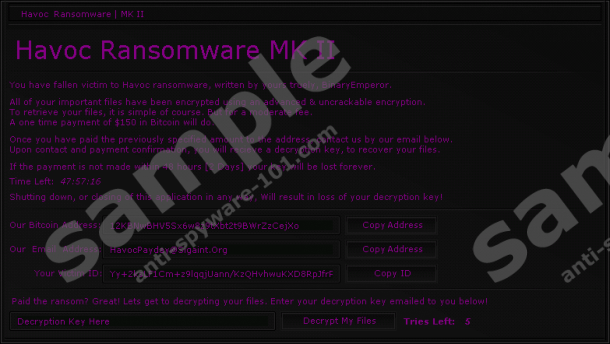What is Havoc Ransomware?
Havoc Ransomware is a recently developed malicious application. It should not become a real threat to you because it has been created just to find out whether it is hard to develop a ransomware infection. The author of this threat says that Havoc Ransomware will not be spread publicly; however, it does not mean that this infection is harmless. Bad people might steal the source code of this threat and then start spreading this computer infection through the web, so we believe that it is important that you know what to expect from it. To be frank, it does not differ much from older ransomware infections developed some time ago because its main purpose is to obtain money from users too. Also, it encrypts files which are located on Desktop and its subfolders. Finally, Havoc Ransomware opens a window with a ransom note when it finishes encrypting files. As it is already known, this computer infection has been created just for fun, so it should not be widely distributed and affect many users. Of course, if it ever happens that you discover this malicious application on your computer, go to delete it from your computer as soon as possible and do not transfer the amount of money indicated in the ransom note. Never send money to cyber criminals if you encounter a ransomware infection because your money might be taken and you might not get anything in exchange. Also, users support cyber criminals by paying money to them.
What does Havoc Ransomware do?
It is not likely at all that Havoc Ransomware will become a prevalent threat in the future, but we still wish that you find out more about it in case you ever encounter it. First of all, it has been found that this file-encrypting threat works only on those computers that have .NET Framework v4.5 installed. If ransomware detects it on the system, it starts working immediately, i.e. it starts encrypting files placed on Desktop and its subfolders. All encrypted files receive a new filename extension .HavoCrypt and the dot between the name of the file and its original extension is replaced with the underscore character, for example, picture.jpg becomes visible as picture_jpg.HavoCrypt. Once all the important files can no longer be accessed and the encryption process finishes, a new window with a ransom note is opened by Havoc Ransomware. Users are provided with the following piece of information: “All of your important files have been encrypted using an advanced & uncrackable encryption.” On top of that, it is also said there that a ransom of $150 in Bitcoins has to be sent to get the decryption key. Most probably, Havoc Ransomware will never make your files unusable because it has not been created to cause trouble for users, but if it happens that its source code is stolen by bad people and you find your files encrypted by this threat, do not pay money by any means. It is because you could get your files back without the special key. Specialists say that clicking 5 times on the Decrypt My Files button (it can be found on the window opened by the ransomware infection) should decrypt all files and delete Havoc Ransomware from the computer, so if users get infected with this ransomware infection, they should try to do that first rather than go to pay a ransom.
Where does Havoc Ransomware come from?
The author of Havoc Ransomware promises not to distribute this computer infection, but you should still know how ransomware infections are spread if anything changes. In most cases, these infections are spread inside spam emails as attachments, but, of course, other distribution methods might be used to disseminate them too. For example, a Trojan infection might drop ransomware on computers too. Also, it might hide on untrustworthy third-party websites. Specialists at anti-spyware-101.com perfectly know that it might be a challenging task to ensure the protection of the computer, so they highly recommend installing a security application. It will protect PC from harmful malicious applications 24/7.
How to remove Havoc Ransomware
Havoc Ransomware not only encrypts files, but also blocks the Task Manager, so it is not so easy to remove it. Specialists say that users can either keep clicking on the Decrypt My Files button until this threat deletes itself and decrypts files, or they can go to eliminate this infection themselves if they ever discover it on their computers. Manual removal instructions (they can be found below this article) will help users to erase Havoc Ransomware manually. Be sure you do not skip any removal step to delete this threat fully.
Remove Havoc Ransomware manually
- Download a third-party program similar to the Task Manager from the web and install it OR click the Decrypt My Files button (it is located on the ransom note window) 5 times - ransomware will delete itself and unlock encrypted files.
- If you choose the first variant, go to kill the malicious process using third-party software.
- Locate and remove the malicious file launched recently.
tested removal of Havoc Ransomware*





0 Comments.